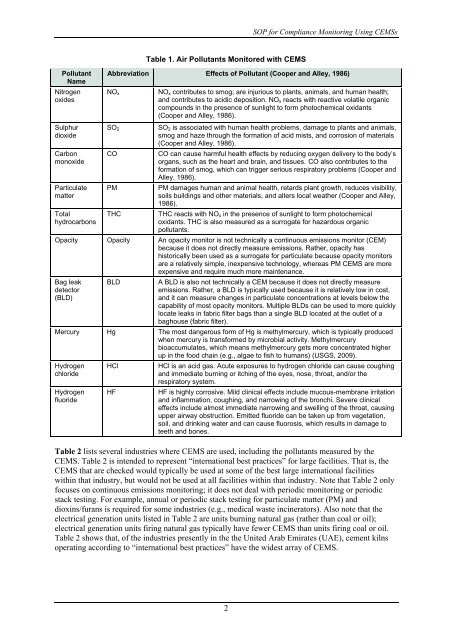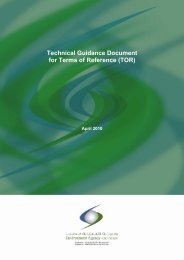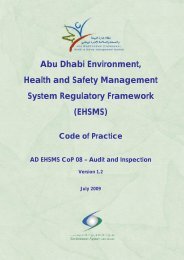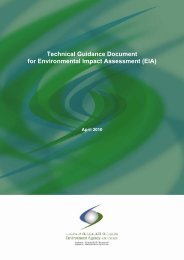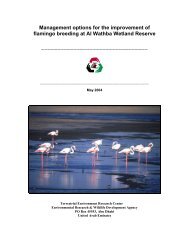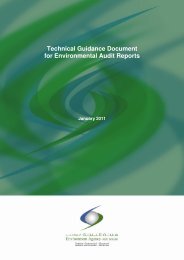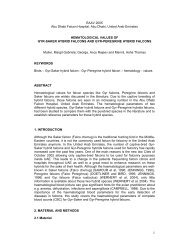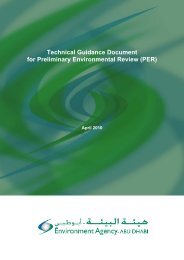Standard Operating Procedure (SOP) for Compliance Monitoring ...
Standard Operating Procedure (SOP) for Compliance Monitoring ...
Standard Operating Procedure (SOP) for Compliance Monitoring ...
Create successful ePaper yourself
Turn your PDF publications into a flip-book with our unique Google optimized e-Paper software.
<strong>SOP</strong> <strong>for</strong> <strong>Compliance</strong> <strong>Monitoring</strong> Using CEMSs<br />
Pollutant<br />
Name<br />
Nitrogen<br />
oxides<br />
Sulphur<br />
dioxide<br />
Carbon<br />
monoxide<br />
Particulate<br />
matter<br />
Total<br />
hydrocarbons<br />
Table 1. Air Pollutants Monitored with CEMS<br />
Abbreviation Effects of Pollutant (Cooper and Alley, 1986)<br />
NO x<br />
SO 2<br />
CO<br />
PM<br />
THC<br />
NO x contributes to smog; are injurious to plants, animals, and human health;<br />
and contributes to acidic deposition. NO x reacts with reactive volatile organic<br />
compounds in the presence of sunlight to <strong>for</strong>m photochemical oxidants<br />
(Cooper and Alley, 1986).<br />
SO 2 is associated with human health problems, damage to plants and animals,<br />
smog and haze through the <strong>for</strong>mation of acid mists, and corrosion of materials<br />
(Cooper and Alley, 1986).<br />
CO can cause harmful health effects by reducing oxygen delivery to the body’s<br />
organs, such as the heart and brain, and tissues. CO also contributes to the<br />
<strong>for</strong>mation of smog, which can trigger serious respiratory problems (Cooper and<br />
Alley, 1986).<br />
PM damages human and animal health, retards plant growth, reduces visibility,<br />
soils buildings and other materials, and alters local weather (Cooper and Alley,<br />
1986).<br />
THC reacts with NO x in the presence of sunlight to <strong>for</strong>m photochemical<br />
oxidants. THC is also measured as a surrogate <strong>for</strong> hazardous organic<br />
pollutants.<br />
Opacity Opacity An opacity monitor is not technically a continuous emissions monitor (CEM)<br />
because it does not directly measure emissions. Rather, opacity has<br />
historically been used as a surrogate <strong>for</strong> particulate because opacity monitors<br />
are a relatively simple, inexpensive technology, whereas PM CEMS are more<br />
expensive and require much more maintenance.<br />
Bag leak<br />
detector<br />
(BLD)<br />
BLD<br />
A BLD is also not technically a CEM because it does not directly measure<br />
emissions. Rather, a BLD is typically used because it is relatively low in cost,<br />
and it can measure changes in particulate concentrations at levels below the<br />
capability of most opacity monitors. Multiple BLDs can be used to more quickly<br />
locate leaks in fabric filter bags than a single BLD located at the outlet of a<br />
baghouse (fabric filter).<br />
Mercury Hg The most dangerous <strong>for</strong>m of Hg is methylmercury, which is typically produced<br />
when mercury is trans<strong>for</strong>med by microbial activity. Methylmercury<br />
bioaccumulates, which means methylmercury gets more concentrated higher<br />
up in the food chain (e.g., algae to fish to humans) (USGS, 2009).<br />
Hydrogen<br />
chloride<br />
Hydrogen<br />
fluoride<br />
HCl<br />
HF<br />
HCl is an acid gas. Acute exposures to hydrogen chloride can cause coughing<br />
and immediate burning or itching of the eyes, nose, throat, and/or the<br />
respiratory system.<br />
HF is highly corrosive. Mild clinical effects include mucous-membrane irritation<br />
and inflammation, coughing, and narrowing of the bronchi. Severe clinical<br />
effects include almost immediate narrowing and swelling of the throat, causing<br />
upper airway obstruction. Emitted fluoride can be taken up from vegetation,<br />
soil, and drinking water and can cause fluorosis, which results in damage to<br />
teeth and bones.<br />
Table 2 lists several industries where CEMS are used, including the pollutants measured by the<br />
CEMS. Table 2 is intended to represent “international best practices” <strong>for</strong> large facilities. That is, the<br />
CEMS that are checked would typically be used at some of the best large international facilities<br />
within that industry, but would not be used at all facilities within that industry. Note that Table 2 only<br />
focuses on continuous emissions monitoring; it does not deal with periodic monitoring or periodic<br />
stack testing. For example, annual or periodic stack testing <strong>for</strong> particulate matter (PM) and<br />
dioxins/furans is required <strong>for</strong> some industries (e.g., medical waste incinerators). Also note that the<br />
electrical generation units listed in Table 2 are units burning natural gas (rather than coal or oil);<br />
electrical generation units firing natural gas typically have fewer CEMS than units firing coal or oil.<br />
Table 2 shows that, of the industries presently in the the United Arab Emirates (UAE), cement kilns<br />
operating according to “international best practices” have the widest array of CEMS.<br />
2


